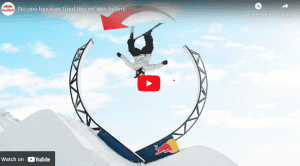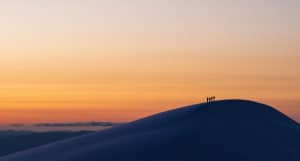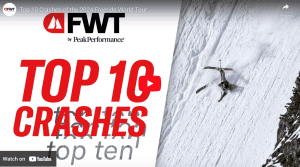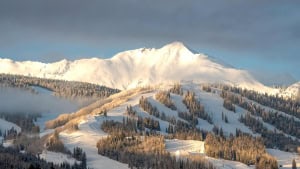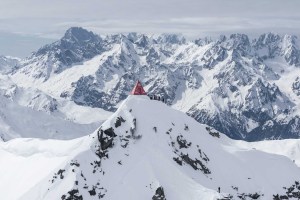The End Zone
![]()

Seth Morrison has been at the forefront of professional freesking for 15 years. It’s easy to see why when he skis a big mountain line this aggressively. Haines, Alaska. (Flip McCririck)
Big mountains, the ultimate skiing experience
By:: Reggae Elliss
One of the biggest developments in skiing over the past fifteen years has been in big-mountain skiing. The annual ski movie releases by renowned producers like Matchstick Productions, Teton Gravity Research and Warren Miller always include big mountain segments and for many in the audience these segments are the high-points of the film.
Accordingly skiers like Seth Morrison, the late Shane McConkey, Sage Cattabriga-Alosa, Jeremy Nobis, Chris Davenport, Andrea Binning, Ingrid Backstrom, Kent Kreitler – the list goes on – have garnered not only an career from their big mountain exploits, but the respect of the skiing world. It is no surprise that skiers like JP Auclair, Tanner Hall and other new-schoolers have not only taken their park tricks into the back-country, but are also starting to ski the huge mountains of Alaska.
They know that if they ever want to be regarded as a truly international skier and to earn real respect, they have to be able to perform where it counts.
And that is on big steep mountains where skiing skill and mountain knowledge can mean the difference between life and death.
“Big Mountain skiing is about taking skiing to its highest and most calculated level,” says Kent Kreitler.
“The most comparable experience is skiing a downhill race like the Hahnenkamm , but even friends who have done that and have also the experience of skiing in Alaska, for instance, are in awe of the circumstances and terrain involved in a real big mountain zone.”
While all modern ski films have some terrain park action, those segments are less prominent now than they were six or seven years ago. While this is a reflection of the sport’s evolution – the terrain park seen as a training ground for the uncontrolled environment of the real mountain – there is also a commercial motivation as well.
According to Seth Morrison , one of the biggest names in skiing for the past 15 years, more people can relate to big mountain and back country skiing than terrain parks.
“From all of the movie tours I’ve been to and seeing people’s reactions to things in the movies, they can relate to the big mountain segments,” says Morrison.
“They are going to, or even just aspire to, go heli-skiing. It is something people can go do ’cause they have a job and they can save up for a couple of years and go on a heli-skiing holiday somewhere. Their ultimate goal is to have that pristine powder and have that experience, just being out in the mountains somewhere like Haines Haines, Alaska.”

Sage Cattabriga-Alosa is one of the new breed of freeskiers throwing down freestyle moves on mountains that matter. (Flip McCririck)
LOCATIONS
That aspiration can be acted upon without having to fork out thousands of dollars to risk your life on a 50-degree slope in Alaska’s Chugach Range. Getting a taste of the big mountain experience is accessible to strong, advanced skiers in plenty of places around the world. Europe has the most lift accessed steep, big mountain terrain with Chamonix and Verbier the two resorts that spring to mind.
For Aspen’s Chris Davenport , former world “extreme’ champ and still one of the world’s leading pro big mountain freeskiers, Europe has it all:
“The European Alps offer something no where else in the world has, a type of lift-serviced skiing that you don’t find in North America because there’s glaciers, there’s crevasses. There’s an element of danger, which North America doesn’t really have. I love the Alps – Chamonix, Verbier. Every time you drive into Chamonix, I don’t care if you’ve lived there you’re whole life, you just look up and go, “Oh my God,” 4000 metres of vertical. The town is 2000 feet and the summit is 16000 feet; it’s big and you never really get used to it. I spend time in Europe every year.”
There are also various North American mountains where accessible backcountry lends itself to the big mountain experience, such as Whistler, Revelstoke, Jackson Hole and Silverton to name a few. More exotic locations include Chile, Argentina and Gulmarg in Kashmir.
Closer to home the heli-accessed backcountry of New Zealand’s southern alps has the wild, big mountain feeling. In Australia the steeps around Feathertop in Victoria and the western faces of the Main Range in the Kosciuszko National Park also offer a big mountain experience.

Mount Carruthers in Kosciuszko National Park (Harro)
PROGRESSION
Chillfactor Magazine’s senior photographer Tony Harrington has spent more time in big mountains than any other Australian skier except for Andrea Binning. He has been photographing the world’s best for 15 years, in locations from Alaska to Greenland, and has witnessed the progression of big mountain skiing first hand.
“It started with people like Trevor Petersen, Eric Pehota, Seb Michaud and Doug Coombs and the focus of “Big Mountain” skiing was in “bagging” the heaviest descents of the biggest and gnarliest mountain peaks there were. Then guys like Shane McConkey, Kent Kreitler and Seth Morrison started getting creative with freestyle moves while hammering down a big mountain.
“The past 10 years added a new dimension to the sport of Big Mountain skiing. Freestyle skiing was getting pushed way beyond the boundaries of what was possible in resort terrain parks, so much so that a new kind of skier was emerging to take the sport to the next level. The same lines that we’d been skiing in the ’90s were reassesed, this time with the gusto of including “new school” moves down an arduous ski line. In the early years an athlete might simply “flash” a line by skiing it hard and fast, including a few mandatory 20-30-40ft or bigger cliff drops with straight airs. Now there are plenty of 720s, switch take-offs and landings and front flips thrown down is some of the most radical terrain you can imagine. Athletes like Sage Catabriga-Alosa, Sean Petit and Dana Flahr have stepped it up further.”

Shane McConkey with his Pontoons – the ski he designed for big mountains and powder. (Hank De Vre)
EQUIPMENT
Much of the big mountain progression is a direct result of advances in equipment, something Davenport is quick to acknolwdge.
“I was skiing well when I won the world extreme championships but I’m skiing way better now. I have the skis I really want, the equipment to step up to the next level. The first time I won in Alaska I was on giant slalom skis, race skis – that was the performance stuff out there. Now we’ve created performance stuff for freeskiing – fat skis that are twin tipped. It’s comparable to the advent of the thruster in surfboards. It was a matter of forget everything we’ve done before, this is it!
That equipment breakthrough didn’t happen by accident and it can be traced back to Shane McConkey’s desire to improve he equipment he was using was the one who came up with not only wider, fatter skis at a real length, but in the late ’90s he also came up with rockered, or reversed, cambered skis. These designs are now not only standard for big mountain skis, but also for powder-specific skis and all-mountain resort skis. McConkey’s rocker idea has even crossed over into snowboarding.
“Shane developed rocker, which is the biggest design advancement I have ever felt on a snowboard,” says Jeremy Jones, one of the world’s leading free-riders. “Having a groundbreaking idea is one thing, but getting a company to invest large sums of money into unproven technology that goes against 100 years of technology is Shane’s greatest achievement.”

Jessica Sobolowski, Switzerland – Europe is a big mountain skiers paradise. (Lang-Willar)
MOTIVATION
One of the major attractions of skiing and snowboarding is being in the elements and experiencing nature in its many moods. Skiing by yourself or hiking outside the resort boundaries is a simple way to experience the mountains and feel like you are a thousand kilometres away from the daily grind of every day life. When you talk to mountaineers or big mountain skiers, they’ll talk about that feeling on an almost spiritual level.
“Whether you’ve climbed out of a helicopter, a gondola or slogged it out on a hike to the top of a peak, one things remains the same every time,” says Tony Harrington. “It is just the feeling of pure exuberance of what is around and below you – miles of magnificent landscape and beauty. It’s a most gratifying and emotional experience It’s a sense of achievement knowing that all those years you’ve put into the sport, all that passion has paid off with an incredible experience. All this and you haven’t even skied down yet…. Now the fun (read “rush”) really begins.”
Click on any image to open the gallery



.jpg)













